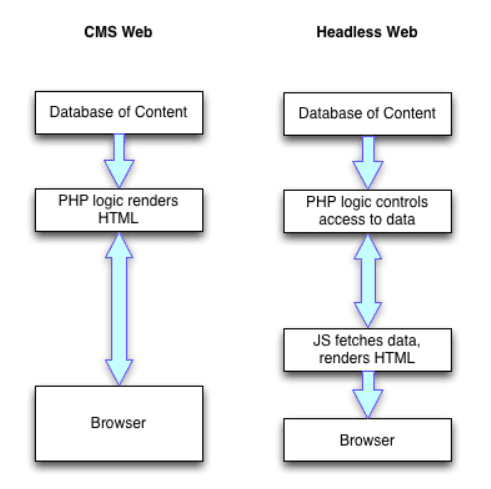When it all started, WordPress was considered a simple blogging application. However, with time and the contribution of numerous technology enthusiasts from all over the world, WordPress has become an entire Content Management ecosystem.
Only they know how long and arduous they have gone from being a simple blogging app to a popular content management system.
One more way to make a website more impactful is by hosting this content in a headless environment. With this approach, the website’s content database is decoupled from its website, which means that it allows more flexibility, a multi-channel approach, and faster performance.
How WordPress, as a headless CMS, would benefit your website? Such as why it will be essential for your business. Let’s discuss that in this article.

What Does It Mean for WordPress to Be Headless?
Before we start talking about headless WordPress configuration and how it differs from traditional WordPress, you first need to understand headless content management systems in general.
There are CMSs that you have probably worked with that handle the front end of the website (called the web interface) and its back end. The back-end is where you create, assemble, and organize the content you plan to use.
When visitors view the front end of the website, we expect they will see the content from your content management system’s back end.
We can say that this type of setup is a “coupled” CMS architecture because it includes user-interface editing tools and management tools on the same installation.
Since both the back-end and front-end are built using the same language and framework, this setup is popular among beginners. Beginners and small businesses should also consider investing in data mining tools since they are game-changers for every enterprise.
However, the headless CMS operates differently. It separates the front-end part (the “head”) from the back-end (the rest of your website’s “body”).
With headless CMS, you may still create, edit, upload, and organize your content. Headless CMSs don’t push the content directly to the front end. Instead, they usually only make their resources available to a separate front-end application through a REST API.
The last thing they think about is how the content looks to visitors.
With this setup, you can access the database only from the back end of the installation.

Even though the headless CMS isn’t the best solution for all WordPress users, sometimes this configuration is a perfect fit. Let’s see why some businesses might want to try a headless CMS.
Benefits of a Headless WordPress Configuration
There are many reasons why someone would choose to employ a headless WordPress installation as opposed to a traditional one. Some examples include the not-in-my-backyard effect, practicality, or scalability. Here are the main reasons why a headless WordPress architecture could create a better site:
Improved Performance
One of the benefits of transitioning to a headless website is faster site loading speed. WordPress traditionally uses PHP, which causes the server to request more data than it needs to generate a site. Site loading speed, then, may slow down.
Also, some plugins may slow down your website, and here’s a guide on how to find out which WordPress plugin is slowing it down.
On the other hand, because headless WordPress uses frameworks like Vue.js, React.Js, etc., the web pages are not produced every time a user sends a request. In these cases, the pages are static HTML, and only the part that needs to be updated gets updated.
It makes it possible for the page to load faster. That makes your customer’s user experience much better.

Front-End Flexibility
WordPress provides you with a good amount of customization options for the user interface. As such, so many WordPress users love the ability to change things about the front end.
However, some people feel constrained by WordPress and then want to build the user interface from total scratch. Such people can achieve a sophisticated front-end with WordPress headless.
For people like those, headless WordPress is the best option.
Besides, there is no mandatory formula when setting up a headless WordPress site. WordPress users can take advantage of many Javascript frameworks. They can use whichever framework they prefer to build the front end of their WordPress site.
Therefore, if you want to redesign your website or build it from scratch, with headless WordPress it is much easier. No matter how much you change your website’s looks, the content remains the same.
However, if you own a website with low traffic and your business is not so big that you need to use CRM, the time, cost, and energy wouldn’t be worth the switch.
Multichannel Publishing
For small businesses, you can use a traditional WordPress site for desktop and mobile devices. However, if you want a bigger business that can scale across multiple platforms, including social media platforms, IoT platforms, etc., you might be unable to do it.
Headless WordPress allows you to build a website that can be published on multiple channels, like social media sites, mobile apps, smart devices, and virtual assistants like Siri or Alexa.
The good part is that, as soon as you make the changes in the CMS, you will be able to see them on all the platforms automatically.
Improved Security
We don’t say it will be impossible to locate and access your database, but we guarantee it will be much more difficult when your front-end and back-end are separated. Due to the front end being independent, it is harder for hackers to approach your valuable data.

Okay, there are some things you can do to prevent people from being able to access your data and protect yourself from threats without going headless. However, the security benefit is yet another bonus of having a headless setup.
Drawbacks of a Headless WordPress Configuration
Again, don’t forget that headless WordPress isn’t an ideal option for everyone. It is not a solution to apply that technology just for the sake of applying it.
WordPress CMS is an experience that doesn’t require coding. However, when it comes to headless WordPress, that is not the case. If you are not comfortable with front-end programming languages like JavaScript, you’ll need to hire someone who can build you the headless part.

Also, when you use headless WordPress, you have an extra workload since you have to look after two systems instead of just one.
Here you can see the top ten places where you can find and hire freelance developers.
Conclusion
Headless WordPress is growing in popularity among people using WordPress. But it is definitely not for everyone.
It is outstanding for a few distinct things and if you’re willing to experiment with new technology, it is a good place to start. Yet, for most small businesses and individual WordPress users, it’s not worth the setup.
Nevertheless, big businesses that need a total solution that runs on both mobile and desktop platforms should definitely consider investing in a headless CMS.